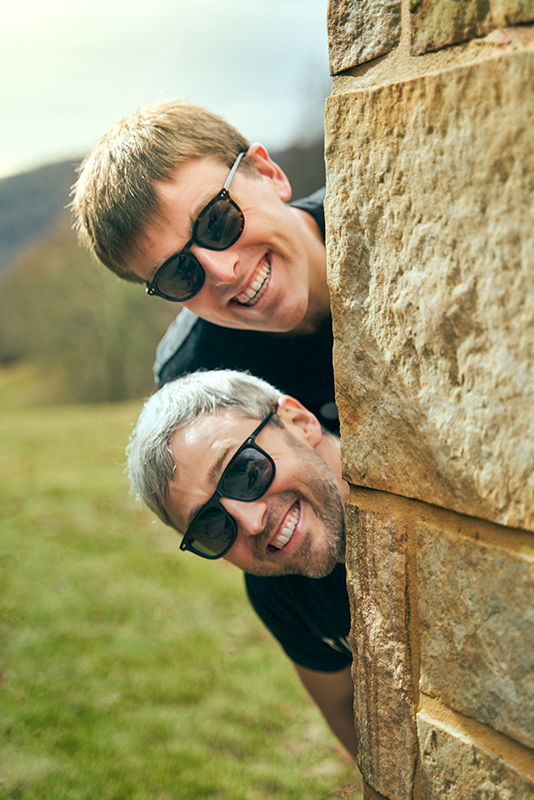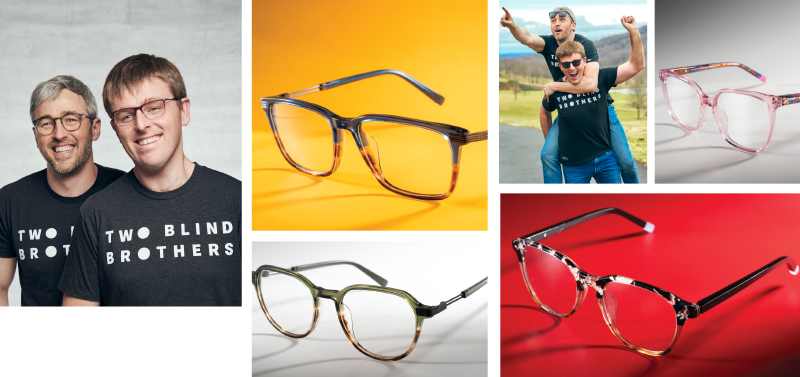
Here at 20/20, we always get the inside scoop on new eyewear products, collections and collaborations. Over the years, we have seen everything from celebrity-designed eyewear and athlete-endorsed sport frames to branded eyewear collections and exclusive styles from furniture and textile designers. Eyewear is constantly changing, and so are the inspirations and designs behind our favorite accessory. That’s why when a unique and philanthropic collaboration falls on our radar, our goal is to learn more about it.
At Vision Expo West in Las Vegas last fall, we sat down with L’Amy America to discuss a new and exciting collection under their portfolio. They introduced us to Bryan and Brad Manning, founders of Two Blind Brothers, a company that creates luxurious and ultra-soft designer clothing and accessories. The company’s name comes from Bryan and Brad’s diagnosis of Stargardt, a rare genetic eye disease that causes blindness over time. The brothers and their brand are on a fervent mission to cure blindness with 100 percent of their profits being donated to the Foundation Fighting Blindness and other organizations that research retinal eye disease. The brand has been on an amazing journey so far and has donated 1.7 million dollars to preclinical retinal research through the Foundation Fighting Blindness, as well as contributing roughly 1.5 million dollars to other charitable blindness organizations through production and marketing partnerships. Their collaboration with L’Amy is just another effort to increase these donations and awareness.
After just a few minutes of listening to Bryan and Brad converse back and forth about their lives, diagnosis and story, we were immediately intrigued. Their passion for the Two Blind Brothers brand and their community was apparent in every word they spoke. Their wit, knowledge and brotherly banter are what make them such a unique duo. The new 2BB: optical collection from L’Amy America is just another example of their drive and passion. The collection consists of 16 styles for both men and women constructed with acetate and metal materials in captivating colorways. Frames offer a tactile feel which was an important design detail to incorporate into the collection, and every frame is named after a notable contributor to the field of optometry. You will find raised braille on the temple tips of each frame, that translates to “brothers,” a subtle yet meaningful ode to Bryan and Brad. Ten percent of sales for the 2BB: eyewear collection is contributed to Two Blind Brothers, which then in turn is donated directly to the Foundation Fighting Blindness and other clinical organizations, all of which translates back to the ethos and foundation of the Two Blind Brothers company.
So, what exactly sets this collaboration apart from others that 20/20 has covered in the past? It is a collaboration with a mission. A mission to cure blindness powered by two caring people who have made it their goal to help the visually impaired community that they have long been a part of. It’s important for us to get Bryan and Brad’s story out there to not only the optical community, but to anyone willing to listen to their incredible journey. And who better to tell that story than the brothers themselves? We wanted to ensure we gave our readers a first-hand view of the inspiring story behind Two Blind Brothers and their new collection with L’Amy, so we asked Bryan and Brad to interview each other. And boy, they did not disappoint.
–Victoria Garcia

BRYAN: You were diagnosed first with Stargardt disease. Can you tell me a little bit about what Stargardt is and what that moment was like?
BRAD: I would be happy to educate you on it. Stargardt disease is a juvenile form of macular degeneration where you lose your central vision over time, and it’s an incurable disease. The way that we were diagnosed, or I guess as the older brother I was diagnosed first, is I failed the kindergarten eye chart, which started this two-year hunt to figure out what had happened to my eyesight.
BRYAN: Can you walk through what not having central vision means?
BRAD: For us with Stargardt, when you lose your central vision, things like reading, recognizing faces and driving are out of the question. So, the tough part about it is that you don’t know exactly where you’ll end up. It’s a degenerative condition. But we’ve met a variety of people, and rarely have we met somebody with Stargardt who has a cane or a guide dog.
BRAD: My question for you, Bryan, because this is a fun one. How the heck did you end up co-founding this project called Two Blind Brothers?
BRYAN: I hate co-founding because I feel like I did most of the work. So, you getting a “co” is a little upsetting to me. Brad and I moved to New York, and Brad kind of told me that he wouldn’t hang out with me because I was a terrible dresser, and I looked shabby. So, we went to Bloomingdale’s of all places. I don’t know if you’ve ever been around anybody with Stargardt disease, but anybody with an IRD (inherited retinal disease) or bad eyesight, we walk through the stores and touch everything like we’re 5 years old. This is because it takes forever to get the label, take a picture, make sure it’s the right size, and it’s a good price. Basically, it takes 10 minutes to look at one shirt, so you have to love that quality. When you’re blind or visually impaired, you do rely on your other senses significantly and more heavily, and your sense of touch is a big one. About 45 minutes after Brad and I had walked in the store, (we had lost each other in the first three minutes) we ended up buying the exact same shirt. But the idea is, how is this possible? There are 50,000 pieces of clothing in all of Bloomingdale’s, how do we come out with the same one item? It was that sense of touch. It was that sense of feel that we could get our hands on. It felt amazing. And then we said, “Let’s start a project around this. Let’s make the best-feeling apparel and clothing in the world, and then let’s donate 100 percent of those profits back to finding cures for blindness.”
BRYAN: Tell me about L’Amy, our newest and potentially greatest endeavor to date. How did we meet them?
BRAD: One of the things that we sell besides clothing are guide dog stuffed animals, and L’Amy (who we hadn’t known at the time) reaches out to place a wholesale order of these plush dogs for their sales team. The stuffed animal guide dogs are in partnership with a couple of different guide dog organizations that train dogs to help people who are blind and visually impaired regain independence.
And then of course, any profits from them come back to retinal research because that’s where we donate all our profits. Then, we gave a talk at an optometrist conference that L’Amy was attending, and the team came to us and said, “I think that this community resonates with your story quite deeply, and we want to explore the idea of helping you launch a Two Blind Brothers eyewear collection.” As soon as they said it, it was unbelievable because our whole brand is about helping improve vision, and it’s where 100 percent of our profits go. It just sounded so right.
BRAD: Can you tell me a little bit about the Two Blind Brothers optical eyewear collection?
BRYAN: I thought you’d never ask. We are able to leverage our passion, energy and love into a single product. You want to be able to put these glasses on and love how you look. They are unbelievably lightweight and the materials are as finely crafted as possible. We have the little two dot “B” on the temple tip to show the Two Blind Brothers branding, which is great because it’s subtle. A portion of every single frame [sold] is going back to curing blindness. So not only can these glasses represent who you are from a fashion and style perspective, but you also know the pair you are wearing has the potential to help 11 million people in the United States find treatments, preventions and cures for blindness.
BRAD: Very well said. I can’t believe you got us 90 percent of the way there. The one thing I would say is that any dollar that we would theoretically make from this collection goes directly to the Foundation Fighting Blindness, which is the organization we’ve supported since we were kids.
BRAD: I want to ask you what your hope is for the Two Blind Brothers eyewear collection. This time next year, what do you hope the impact is of this collection?
BRYAN: My genuine hope is that when Two Blind Brothers is on the optometrist board, they feel really strongly and really good about the glasses they’re giving to patients. That they get to have pride and ownership of this collection because it was designed from a place of love for this community. The greatest hope is that a ton of people copycat us, right? It would be amazing if 50 brands were doing what Two Blind Brothers is doing.
BRAD: Well, you said all the good stuff, so thanks for leaving me nothing. There’s an irony to the idea that Two Blind Brothers is making a pair of optical eyewear. When we walked into that optometrist’s office 30 years ago we were told that we may have a severe eye disease and now to be back in that office 30 years later with our frames on the wall. It’s not about us. Having an eye disease, having poor vision… It doesn’t make you any worse than anybody, but it also doesn’t make you better than anybody. It’s the idea that we’re all on this shared experience called life that’s full of challenges. It’s about getting the hands that you’re dealt and playing that hand the best that you can. That’s what we’re measured by. I’m hoping that that will come through for the people who end up wearing this collection.
BRAD: Tell me a little bit about the new launch of the Two Blind Brothers sunwear collection.
Bryan: Fun fact. The best way to prevent loss of vision is to wear sunglasses when outside. It is the number one way to do it. There are no ifs, ands or buts about it, but so many of us do not wear proper sunglasses. That’s because the lenses are not high enough quality to protect your eyes, they’re too expensive, they’re too heavy or they don’t fit right. With the new Two Blind Brothers sunwear collection with L’Amy, we have gone overboard. The lenses in these glasses are unparalleled and unbeatable. You will not find a higher quality lens to protect somebody’s vision. We have priced them so people can afford to wear them.
BRAD: Like Bryan said, there’s nothing better we can do for people to prevent vision loss than produce sunglasses that they can afford and that they want to wear. There’s just one other detail that I wanted to mention about the sunwear. We’re working with a group called Bosma, who hires blind and visually impaired workers, and they’re the ones that are actually performing the packaging of the sunglasses.
BRYAN: And outside of the nuts and bolts of it, the reason we like to do it, and we do this with other organizations up and down the East Coast or across the United States, is unemployment in the visually impaired community is astronomically high, which is terrible.
BRAD: Well done.
BRYAN: Thanks, buddy.










